Spring flowers are undoubtedly one of the main decorations of the flower bed and the local garden after a long and cold winter. There is a huge number of blooming plants that please us with various shades immediately after the snow and thawing soil.
These are tulips, and daffodils, and valley. However, in addition to these colors there is another, which strikes with its delicate petals and celestial blue. This is Kamasia - a flower, the small flowers of which are dissolved only for one day in the late spring. American guest loved to many gardeners and landscape designers from around the world, no exception and our gardens. In Russian districts, Kamassea is less common, but every year its popularity is growing.
In this article, we will look at the features and description of Kamaassia, we describe the most popular varieties of this plant. We will tell about the most important nuances of agrotechnics of growing and care for this flowering plant.
Features and description of Kamaassia
Kamascia is a perennial herbaceous flowering plant, which refers to a small hyacinth or lily family. The natural area of \u200b\u200bhabitat of this long-term bulbous plant is the territory of North America and Canada. It is here that you can find delicate kamassey flowers growing at open solar plots of mountains and meadows, as well as on the banks of the rivers. In total there are 5 described and studied types of Kamassea, which grow only in America. In Europe, this flower was also quite widespread, especially due to its unpretentiousness and gentle flowers. Increasingly, Kamassia can be found in alpinera and rockers of European gardens.
In Russian gardens, KAMASSI is much less common. Unfortunately, our gardeners are caution relate to new plant species, and some have never even heard of such a flower as Kamasia. This is a perennial plant takes their roots from the Indian tribes of North America, which were used by the Kamassey Lukovitsa in food. Some of her species are still considered edible. The current name of the culture was given in honor of the scientist who first discovered this plant and explored.
Description of Kamasia:
- Kamasia is only perennial plants that instead of the roots have bulbs.
- These bulbous plants grow up the close up with a back of the roasting leaves.
- The leaves appear much earlier than the flowers and the blooming of the colors themselves.
- In the color of the leaves are green with a small squint.
- In the form of roasting leaves, lancing and elongated, in length can reach 60 cm, and in a width of 5 cm.
- The Kamassey Bulb is small, in diameter can reach 5 cm. Covered with film and flakes, which are simultaneously dry, inquiring and crumbling.
- From the roar rosette of the leaves grows up a reprehensive stem, on the top of which inflorescences are blooming. In the height of the blooming can reach 1 m, depending on the specific flower variety.
- Flowers have small plants, reach only 3 cm in diameter.
- All colors are collected in case-shaped inflorescences, which may consist of an average of 100 flowers.
- In nature, there are completely different flowers of Kama ash: blue, blue, purple, white, cream.
- The flower itself is very reminded by a reduced copy of lily. It consists of perisheries, divided by 6 pieces, one of which will be rented.
- Flowering Kamasses begins at the end of spring or early summer.
- An interesting feature of Kamassea - one flower taken blooms a maximum of a day. But since in inflorescences of their approximately 100, bloom lasts a few weeks.
- The fruit of the plant is a triangular box with a large number of black seeds.
- Kamaassia is relatively resistant to cooling, can withstand frosts up to -15 degrees.
Variety of species and varieties of Kamaassia
To date, only 5-6 types of Kamassea are studied and described, which in nature are growing only in North America. Consider the features of common types of Kamaassia.
Kamaassia Leichtlin
- One of the best-selling varieties of Kamazassia in Russia.
- Leichtlin Kamaassia grows on solar meadows in North America in its moderate climate.
- This is a rather large and powerful flower, whose bloomout can reach a height of up to 100 cm, and sometimes to 130 cm.
- Leaves oblong up to 60 cm long.
- Flowers are large up to 4 cm in diameter.
- Flowers are blown upwards until it blooms completely all the inflorescence consisting of about 100 flowers. The length of the inflorescence can reach 20 cm.
- The flowering of the KAMASSSI of this variety begins at the end of May. The approximate duration of this period is 15-20 days.
- Leichtlin Kamaassia flower can be different shades: dark blue, purple, cream or white.
- The bulbs of this species are quite large, reach in diameter 4 cm. Are edible.
- Based on this type of Kamaassia, a large number of decorative forms have been created.
- Kamaassia Leichtlin Alba is characterized by white flowers with a small greenish yellow tint. Height reaches 60 cm.
- Kamaassia Leichtlin Semiplena is a rare form, which is distinguished by terry beautiful flowers. Flowers creamy-white.
- Kamaassia Leichtlin Electra Another pretty interesting view of Kamaassia. Differs on large star-like bluish-purple flowers.
Kamassia Kuzika
- Kamik Kamassia variety in nature grows on the mountains of the Western territory of the United States. Named in honor of the man who first saw this flower and described it.
- Blossom starts in mid-May.
- Plant leaves are assembled at the surface of the earth. In the form oblongs up to 40-80 cm in length and up to 5 cm in width. In the color of green with a jack.
- Stems upright, up to 100 cm in height.
- On the tops of the stems there are high-shaped inflorescences up to 40 cm in length, which consist of 40-100 flowers.
- Flowers in inflorescences are small up to 3 cm in diameter. The shade of the colors of the celestial blue, which looks very unusual in combination with long golden yellow stamens.
- This type of Kamaassia has several bulbs, which in diameter reach 5 cm and up to 9 cm long. The bulbs smell unpleasantly.
- One of the most interesting and popular varieties of Kamassia Kuzik is Zwanenburg. Different with larger flowers with an unusual shade - bluish-purple.
Kamasia Kvamash
- The natural area of \u200b\u200bhabitat of this type of Kamazia is the Taiga Zone of Canada and North America.
- The bulb is a spherical, which in diameter reaches 5 cm. The color can be black or brown. The bulb of this type is edible.
- In the height of the Kamassia flower Kvamash reaches 30-80 cm.
- Leaves of plants are oblong, up to 40 cm long. Located near the surface of the Earth.
- Flowers are collected in busy inflorescences up to 20 cm long. One inflorescence can consist of about 35 flowers.
- Color shade can be different: blue, blue, purple or white.
- There are several natural forms of this type of Kamaassia. For example, the Azurea Kamassea is a dwarf shape with bright blue flowers, and Kamassea Breviflora is an alpine form of this species.
- In addition to natural forms, there are also the garden, which were brought by breeders. Kamassea Orion amazes with its bright dark blue flowers. Kamasia Blue Melody is distinguished by touches of beige color on the leaves.
Kamaassia phrasrae
- Prefers to grow on meadows and forest glades in the United States.
- The view of Kamassea is named after a scientist who traveled in the US J. Frazer.
- The bulbs in the form are oblong, ovoid, up to 4 cm in diameter. They are edible.
- The height of the entire plant is 70 cm on average.
- The inflorescence is a creeping, maximum in length reaches 20 cm and consists of 20-35 flowers.
- Color shade different: blue, purple, white.
- It blooms in late spring or early summer.
Camassa Howell
- Plant height reaches 60 cm.
- Certain length can reach 25 cm. Which consists of a large number of flowers - about 35-90 pieces.
- Flowers of violet blue shade with yellow anthers.
Reproduction of Kamasia: the most common ways
You can easily breed Kamassia on your own at home. For this use two popular methods: breeding on bulbs-kids and seeds. Having considered the nuances and the features of each method, you can choose for yourself the most acceptable.
Seed reproduction of Kamaassia
- This method is used very rarely, as it takes quite a long time. It can be applied if you want to get a large number of plants at once.
- To begin with, it is necessary to wait for the ripening of seed boxes on adult plants and assemble the seeds of Kamaassia. You can go easier and buy seeds in a special store.
- Kamassey seeds need long-term stratification, since it is at a lowered temperature that the percentage of germination and faster appearance of strong seedlings increases. Stratification should last about 4-5 months.
- It is because of long-term stratification that it is necessary to sow seeds on the prepared bed in the fall. Thus, the seeds for the winter will pass natural stratification.
- Seying seeds need not deeper than 2 cm.
- After landing, be sure to break the crops and inspire peat.
- The first leaves will appear in the spring after the onset of warm steady weather. The KAMASSIA grown from seeds will bloom only after 3-4 years. Remember that after 6-7 years, grown plants need to be seeded.
The reproduction of Kamassey on bulbs-kids
- This method is most often used, as it is easier in performance.
- Many species of Kamaassia form a very well for the bulbs-kids, which facilitates the process of reproduction of this plant.
- First of all, wait until the top of the upper part of the Kamaassia and the ripening of children.
- Next, carefully dig bulbs of KAMASSI, carefully separate the bulbs-kids from the maternal. At the same time, try not to damage the roots.
- After that, you need to immediately put in the soil maternal bulbs and kids.
- As a last resort, you can dry the bulbs in a well-ventilated room and store for a month in a cool place. Also, the bulbs can be placed in a wet peat, but not longer than 1 month.
Stages of preparation before landing Kamazassia
Kamassia can be raised without any problems in the garden plot, especially since this plant can withstand a decrease in temperature to -15 degrees. However, for this it is necessary to carefully prepare, acquire a high-quality planting material and find the perfect place to land. Consider all the nuances of the landing of Kamaassia into open ground.
Stage 1. Selection of the grade and planting material of Kamaassia
- Kamasia is still a rare guest in our gardens, but you can find and acquire interesting and unusual varieties of this plant.
- You can buy Kamassey bulbs in specialized nurseries or garden centers that are professionally engaged in breeding various plants.
- You can buy the most different grade of Kamassea, as they can carry winter frosts. When choosing a specific variety, focus on future garden compositions. Higher varieties of Kamaassia Leichtlin can be planted in the background of flower beds and rocaries, and varieties, such as Kuzik Kamassia, in the central part or as the framing of garden tracks.
- Before buying, you can consult an employee of the Center on the peculiarities of the cultivation of Kama Asia and the main nuances of care and reproduction. In this case, you can choose the grade of kamassey, more suitable for your climatic conditions.
- Also before buying Kamassey bulbs carefully inspect them. On the landing material should not be visible damage, signs of drying and pests.
Stage 2. Choosing a place for landing of Kamaassia
- Kamascia is a sun-born plant. It prefers to grow on well-lit groups of flower bed. However, with a light shading, the kamassey flowering will last a little longer. Therefore, it is best to find a place on your garden plot with a small shadow at noon time.
- Place of landing of Kamassea will depend on the flowered flower bed.
- The tallest grade of Kamaassia will excellently look at the backdrop of flower beds, club, alpianaray and rocaries.
- The average grades of Kamassea can decorate places along the garden tracks and borders.
- When choosing a landing room, avoid lowland where water is stared. The bulb can be controversial.
- It is also important that the selected area is protected from strong wind and draft.
Stage 3. Choice and soil preparation for landing of Kamaassia
Kamascia prefers to grow on fertile soils. For the full growth of this blooming plant, pick up a plot with clay ground or any other that can hold moisture and air. Also, KAMASSI can grow on heavy soils, the main thing is that the place is well drained. Otherwise, the bulbs can suffer and the plant will die.
Since the landing of Kamaassia is carried out in the fall, the landing place can be prepared in the spring. To do this, turn the soil to the shovel about the bayonet shovel, removing all weeds.
Landing Technology Kamassea in Open Soil
- In the open ground, the landing of Kamassea is carried out in the fall, since it is necessary for the full growth of this plant.
- Prepare a place to land before the landing. To do this, again we will shry the plot, add a little peat to the soil, humus and mix well. Then crush the site.
- Since the Lukovitsa Kamassea is not stored for a long time, specialists are recommended after separating the bulbs-kids to plant them immediately into the soil.
- When buying it in the store, store until the landing in a wet peat, and in front of the landing itself gently remove from the containers, trying not to break the roots.
- On the crumpled section of the garden, take the landing wells with a depth of 15-20 cm. The distance between the wells should be at least 15 cm for their full growth and development.
- Since Kamaassia prefers drainaged soil, a few small stones and gravel can be placed on the bottom of each well. It is necessary to prevent stagnation of moisture at the bulbs.
- Next, carefully separate the kids from each other and place it in the wells. After that, sprinkle soil and carefully press your hands.
- After landing, paint each well and climb dry peat or sawdust. This is necessary so that Kamahasia does not frozen during a honest winter.
Kamazassia Growing Agriculture: Secrets and Nuances of Care
Kamasia is considered an unpretentious plant, so its cultivation will not be difficult for even inexperienced gardeners. Following the simple and understandable rules for the care of Kamassia, you can grow in your site this is a gentle plant. The main stages of the care of this perennial flowering plant is watering, loosening, feeding and combating diseases and pests.
Watering Kamaassia
Kamaassia prefers to grow in a wet soil, but it does not endure the long stagnation of water. When developing a watering mode, it is possible to focus on the state of the soil around the plant. Watering is necessary at the moment when the surface dried slightly. Usually, the KAMASSSI is enough 2-3 irrigation a week, especially at the time of flowering. After flowering, watering can be cut. Watering Kamassey is necessary in the evening and only warm water room temperature.
Ruffle and mulching of Kamaassia
After irrigated the soil around the kamassium, it is necessary to loose, as these plants need constantly influx of air. Drops carefully, deeply without blocking the blade. Be sure to remove all weeds that appear around the plant. They can slow down the growth of Kamasse and interfere with it in development. After landing in the fall and in the most arid period of summer, the soil around the Kamassi is recommended to be mounted to prevent the moisture evaporation, as well as to protect against cold weather. As a mulch, use a dry peat or sawdust.
Falker Kamassea
Kamaassia is relatively unpretentious plants, however, for their full growth, fertilizers are required. The first feeding of Kamassi is carried out in spring, after the appearance of the first leaves. As a fertilizer, integrated mineral or nitrogen fertilizers can be used. The second feeding is carried out at the time of the formation of buds. At this time, complex mineral fertilizers for flowering garden plants or superphosphate are also used.
Fighting diseases and pests of Kamassea
Kamasia is characterized by sustainable immunity from various pests and diseases. The most dangerous pest for this plant is considered the root onion tick, which can penetrate inside the bulbs and damage it. To combat it, special drugs insecticides are used, for example, phytodeterm.
Of the diseases of Kamassey, Kamazassia diseases are most often amazed by fungal diseases, and more specifically different types of rot. It is best to carry out preventive work before landing, for this, process the bulbs of fungicides. And to combat the disease, you can use drugs containing copper.
Preparing Kamassea for Winter
When the plants stem die, they must be cut off. You need to do this after their complete flow. The stalks are not completely cut, it is necessary to leave about 5 cm. After that, it is necessary to inspire the soil around the plants with a layer of peat, sawdust or dry foliage. In the spring shelter is removed.
Using Kamassea in Landscape Design
- Kamasia is great for group planting of flowering and decorative plants on clubs, flower beds.
- You can land this plant on the Alpine hill or in Rokaria.
- Flowers of Kamassea look good in cutting.
Photo of kamasia in landscape design
You can more clearly see all the features of the use of this plant in the decoration of the garden area on the photo suggested below.
Kamaassia is a favored guest in the gardens and flower beds of Russia. However, every year the interest in this culture increases, as Kamaassia is famous for its unpretentiousness and sophisticated beauty.

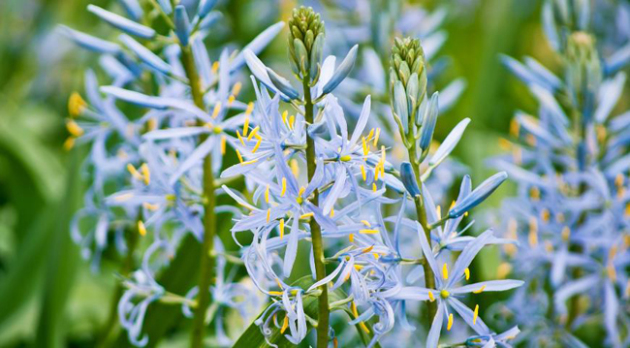
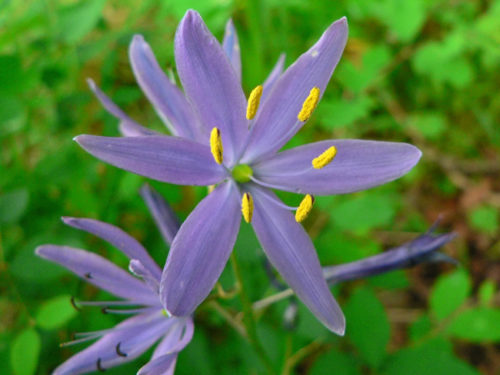

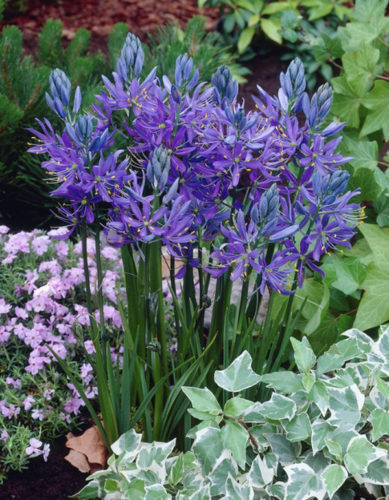
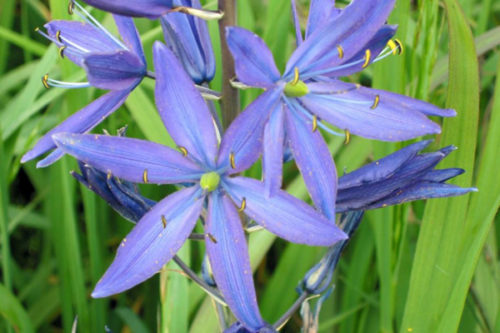
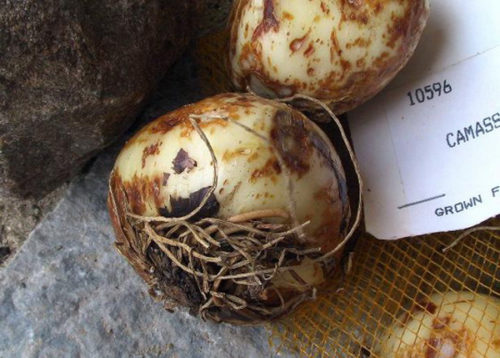
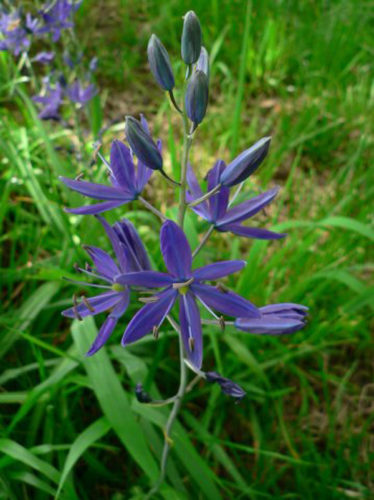
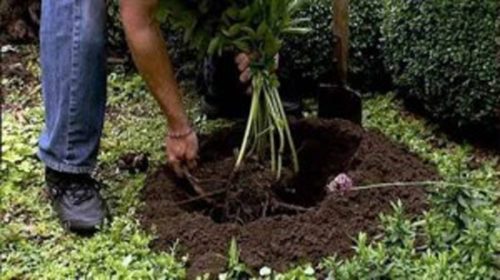
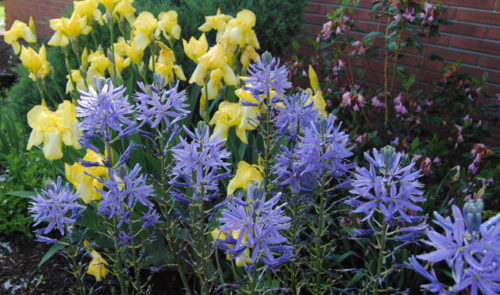
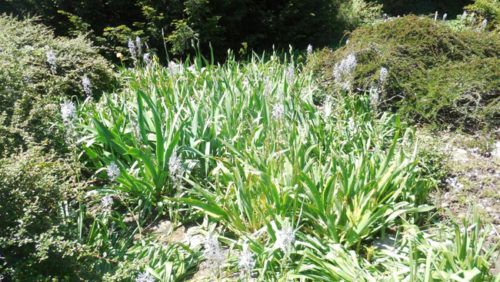
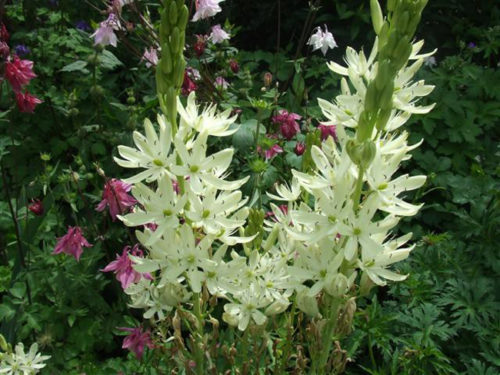
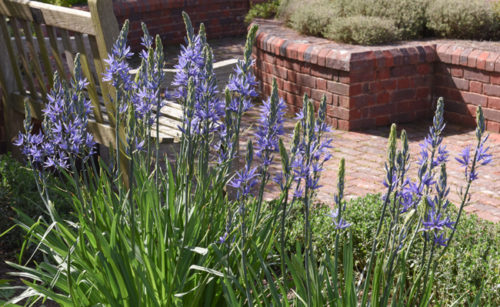












 Start a discussion ...
Start a discussion ...